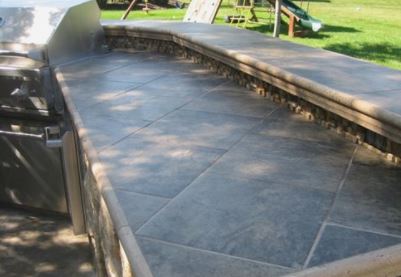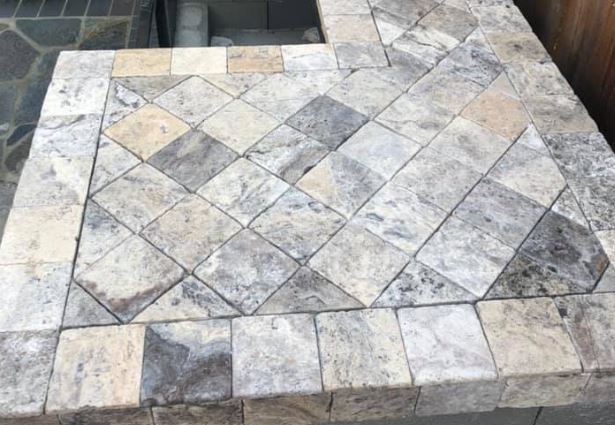How to Seal Outdoor Tile Grout
How to Seal Outdoor Kitchen Tile Countertops
Because tile grout is porous, it is subject to discoloration as food spills, pollen, tree sap, and other contaminants seep in and become stuck.
Physically scrubbing tile grout involves a little bit of effort. To avoid having to spend a lot of time and effort cleaning your outdoor kitchen tile grout, you should use a grout sealer to provide a barrier between the porous grout and the elements and spills and stains.
Grout is a substance that is used to fill up the gaps between tiles. Because mortar holds the tile in place without any additional support, no grout is required to stabilize it. The majority of the grout you’ll use is sanded, which means it contains sand. Manufacturers utilize sand not just because it is very inexpensive, but also because it is an excellent material for a basic task: filling the grout joints. Because sand is porous, grout is also porous.
Unfortunately, once the grout has been poured and dried, it is ready to absorb any liquid, including water. You can prevent water and other liquids from infiltrating the grout by first applying sealant to it. Grout sealer is as easy as that.
What Is Grout Sealer and How Does It Work?
The use of grout sealer is an essential part of the tile installation process. Its purpose is to keep moisture from getting into the grout and under the tiles.
Over time, moisture underneath tiles will create voids and may cause tile to crack. Keeping water from seeping under tiles emphasizes the importance of sealing grout.
Outdoor grout sealer can be used on outdoor porcelain tiles you might use for a countertop, natural stone tiles grout, or any other exterior tile type.
Is Grout Sealer Always Necessary?
Yes, you’ll need grout sealant unless you’re working with epoxy-based grout. Epoxy grout does not require a grout sealer because it naturally sheds water and does not require any additives.
3 Benefits of Grout Sealing
-
- Maintains the appearance of new grout.
- Sealing the grout makes it more water-resistant and hence less likely to be damaged or discolored.
- Aids in the prevention of mold and mildew. Mold and mildew thrive on warm, moist surfaces.
Types of Outdoor Tile Grout Sealer
There are two types of grout sealers that are commercially available to seal outdoor countertop grout.
The first are silicone based tile sealers. These are the less expensive of the two types. They are engineered to seal your grout against water.
The other type of outdoor grout sealers is fluorochemical sealers. Because of their chemical composition, these sealers seal grout against both water based stains and oil-based stains. If you are worried about grill grease or other cooking grease staining your outdoor grout, this is the type to use.
As you never know what kinds of stains your outdoor countertops may encounter, fluorochemical sealers are the better choice. You don’t need very much product to fill your grout joints, a 16 oz container will do as the gallon containers can get quite pricey.
Steps to Seal an Outdoor Tile Countertop
-
Items you need
- Gloves
- (2) Microfiber cloths
- 400 Steel Wool or small brush
- Liquid Grout Sealer
- Neutral PH Cleaner
- Lemon oil
-
Prepare the surface
Remove any debris, tree sap, or spills from the countertop and grout joints with a neutral ph cleaner.
-
Apply the sealer
This method is directed at sealing a grout line. If you want to also seal the tiles at the same time, the same method can be used. If you find steel wool to be too cumbersome to work with on fine grout joints, you can use a small brush for pinpointing only the grout line.
- Wait until the grout has fully cured before attempting to seal the grout.
- Choose a cloudy day or shaded location. Otherwise, sunlight will harden the sealer too rapidly.
- You want to soak the sealer into the grout lines to fill all the voids in the grout that will absorb water or oil stains. In effect, the sealer creates a waterproofing membrane
- Do this by rubbing the sealer into the grout with the 400 steel wool pads, making sure to work the sealer into all the grout crevices..
- Take the first microfiber towel and lightly rub to spread the sealer into the grout lines and any film which may have developed. When the sealer starts to feel tacky, switch towels.
- Use the second towel and keep rubbing. You will first feel more tackiness, then it will start to smooth out. When it is smooth, you can buff the grout lines.
-
Tidy Up
If the sealer has flowed elsewhere on your ceramic tile countertop, stone or tile floors, or appliances, use lemon oil to remove the sealer from those surfaces.
Once your outdoor kitchen grout joints have been sealed properly, only occasional maintenance should be exercised to keep your grout from staining.
Tips for Maintaining Sealed Outdoor Countertop Grout
- Regularly clean your outdoor countertops and grout.
When cleaning outdoor grout, do not use anything other than neutral PH cleaners. These type of cleaners have surfactants which won’t break down the sealer over time.
Vinegar, bleach, cleaners with alkaline or acidic properties will eventually ruin the seal the sealer created.
- Grout lines will become dirty if you leave dirty water sitting on them. After cleaning with the neutral PH cleaner, dry up the dirty water so it doesn’t sit in the grout joints and stain them.
- Sealing the grout every so often with the method described above will help keep the grout intact and stain free.





